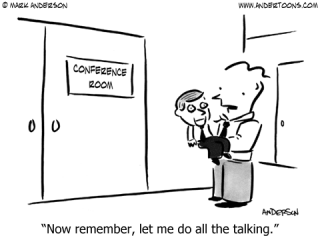Full Article
How to Get Your Phone Calls Returned Quickly... or Ever

Want to increase the likelihood of getting a prompt call-back when you have to leave a voicemail message? Here’s how:
- State your name slowly and clearly. If it’s a tough one like Zbigniew Brzezinski, spell it out so the recipient gets it.
- Give your phone number at the beginning of your message and at the end of your message.
Having to listen to a lengthy message multiple times trying to get the callback number makes your listener’s ears bleed, especially when it is delivered at hypersonic velocity. You know, those numbers that sound like: “gimmeacallat5558403973stension95631” with the last two digits enunciated at such a low volume a bat would get a hernia trying to hear them.
Say the numbers S L O W L Y in short segments so people can write them down like “705…555…55…55” your listener will love you for it.
Don’t make it hard for people to call you back. Take five seconds to do it right – you’ll be pleased with the results.
How to Perfect Your Elevator Pitch
 In the event of an accidental meeting with someone important, you should be ready with a short, 30-second summary of what you and your company have to offer. Your succinct speech should quickly outline who you are, the products or services you provide, and your value proposition.
In the event of an accidental meeting with someone important, you should be ready with a short, 30-second summary of what you and your company have to offer. Your succinct speech should quickly outline who you are, the products or services you provide, and your value proposition.
To make your speech powerful, introduce yourself and then point out a problem for which your company has a solution. Tailor the pitch to your audience’s needs by engaging them with a question. Focus on the unique value proposition which makes you and your company’s products and services stand out.
This is the time to spark an interest in your company – not an opportunity to sell something. Don’t include too much information or industry jargon. It’s okay to mention high-profile clients to build credibility. Leave your audience wanting to know more.
Practice your speech. You want to look and sound natural. Practice so you sound friendly and conversational instead of rehearsed. Convey your speech with confidence!
Many entrepreneurs, business owners, and salespeople rehearse and use elevator pitches to get their points across quickly. If you want to maintain a competitive advantage in your field, put these tips into practice for perfecting your elevator pitch.
– Andrew Phillips, FocalPoint International
The Top Four Signs You Are About to Lose an Employee
 Retention and onboarding are extremely important for every employer. Without effective strategy, plans, and actions in these areas you will experience high employee turnover.
Retention and onboarding are extremely important for every employer. Without effective strategy, plans, and actions in these areas you will experience high employee turnover.
Here are the top four signs your employees are disengaged and disinterested, and the best ways to deal with them:
- Employees feel distanced from colleagues.
Get to know your employees and their relationships with one another. Intervene if you see problems.
- Employees do not feel they are doing meaningful work.
Help your employees understand how their work helps your company meet its goals. Discover what they want to do within your company and help them create a plan to achieve it.
- Employees feel they do not fit in.
Hiring people who fit in with your culture, vision, mission, and purpose is critical to retention. Look for ways your current employees can collaborate and use their skills to support others.
LIVE, EAT and BREATHE your culture.
- Employees feel they are not recognized for their work.
Make it a habit to point out your employees’ hard work and your appreciation for it in front of their peers. Providing genuine appreciation and recognition is critical.
Amazing Your Customers: First Things First
 Customers have expectations that must be met for them to be satisfied. These expectations are both unspoken and spoken. Let’s cover the unspoken expectations first.
Customers have expectations that must be met for them to be satisfied. These expectations are both unspoken and spoken. Let’s cover the unspoken expectations first.
A business must meet unspoken expectations without fail, or the dissatisfaction can be intense. These typically reflect customers’ desires for convenience, respect, and usability, such as:
- “My hotel room must be clean when I check into it.”
- “My cellphone has to work when I need it.”
- “I’d like my soup without hair.”
However, delivering on spoken needs is where real value is created. These are the aspects of your product or service that customers have told you they expect to receive. Their satisfaction with your business will increase or decrease proportionately with your ability to deliver on these spoken requirements.
Spoken requirements generally align with three basic quality attributes:
- The amount of time it takes to do something;
- The absence of defects or rework; and perceived value for the cost.
- A higher value for a given price.
Be exceptional at meeting the spoken and obvious unspoken requirements of your customers. Once you're confident you can deliver on your brand promise every time without fail, then invest time in amazing your customers.
- By Art Locke, MBA Business Performance Coach
3 Compelling Things Effective Safety Leaders Do
 I watched a firefighter who had been battling the Fort McMurray wildfire tear up at being called a hero this week. Then, he displayed class and leadership in his response:
I watched a firefighter who had been battling the Fort McMurray wildfire tear up at being called a hero this week. Then, he displayed class and leadership in his response:
“I don’t consider myself a hero…Our community right now has more firefighters and more first responders, police, everybody, that have given up their own homes… They’re heroes to me.”
That sound bite provided reflection. There are three compelling things that leaders, including safety leaders, do to get results:
- Leaders feel. Leading has to be personal. Good leaders don’t try to hide their vulnerable side in order to look like they are in command. That’s not leadership.
- Leaders give. When someone else is in trouble, leaders give of themselves. They don’t think twice about it. Leaders give the credit to others and it generates greater long-term results.
Leaders lead. They may be the face of the team, but leaders know that every team member is important. Good leaders never asks someone to do something that they weren’t prepared to do first. Leaders do it for the meaningful impact they can create.
- Kevin Burns is a management consultant, safety speaker and author. He believes that the best place to work is always the safest place to work. Kevin helps organizations integrate caring for and valuing employees through their safety programs. For more info and to reach Kevin, www.KevBurns.com. -reprinted with permission.
Use the Power of Time Perspective to Make Great Successes Routine
 The perspective that time brings has a powerful influence on how you think when used positively. One of the strategies I was fortunate to learn years ago is the power of creating a list of your 100 successes or victories. I have found that by creating the list of 100 plus successes in one sitting is the most impactful. Here’s how to do it:
The perspective that time brings has a powerful influence on how you think when used positively. One of the strategies I was fortunate to learn years ago is the power of creating a list of your 100 successes or victories. I have found that by creating the list of 100 plus successes in one sitting is the most impactful. Here’s how to do it:
- List ALL the things that you have learned and accomplished – big and small. You probably won’t be able recall your fist years. If you have children or grandchildren, borrow from them.
- Keep adding to your list. It doesn’t need to be in order, just get them all down.
- Once you have added ALL 100-plus successes to your list, enjoy how you feel and embrace that feeling.
- Narrow that down to a list of your top 10 successes. These are the ones that resonate with you the most.
Refer to your “Top 10” list each day to help you grow into your new extraordinary self-view. Psychologist Albert Bandura says we tend to go through our successes too fast and take them too lightly; if we stop taking our accomplishments for granted, we will continue to do, be, and learn.
- by Coach Phil Gilkes
14 Retail Selling Tips to Supersize Your Sales and Boost Profits
 Retailers can boost revenues and profits by utilizing great selling techniques. We’ve collected the top 14 tactics for dealing more productively with customers and making your cash registers ring.
Retailers can boost revenues and profits by utilizing great selling techniques. We’ve collected the top 14 tactics for dealing more productively with customers and making your cash registers ring.
- 1.Get out on the sales floor.
- 2.Start a dialog with the customer. Engage in a conversation. Ask questions.
- 3.Stay with the customer. Don’t just point the way.
- 4.Let employees say “yes.” Empower your team.
- 5.Offer a choice. This gets your customer beyond the “Should I buy or not?” question.
- 6.Discuss the best merchandise first. Shows respect for your customers.
- 7.Promote the entrance area. Build excitement immediately.
- 8.Position demand merchandise in back. Get customers walking through your store.
- 9.Display impulse items at checkout. Show small-ticket, high-margin items.
- 10.Change displays often. Stimulate customer interests.
- 11.Improve your adjacencies. Encourage tie-in sales.
- 12.Post interpretive signs. Explain product benefits.
- 13.Brighten your walls. Create new interest.
- Spotlight your displays. Use lighting to make displays pop.
These 14 tips reflect a customer-centric attitude. Initiating great conversations, creating thoughtful displays, and brightening the showroom work together to solve the problems and improve the lives of customers.
You Can Always Get a Better Deal - The Law of Unlimited Possibilities
 The Law of Unlimited Possibilities says: You can always get a better deal if you know how.
The Law of Unlimited Possibilities says: You can always get a better deal if you know how.
The first corollary of this law says: “If you want a better deal, ask for it.” The top negotiators will quite calmly and confidently ask for any kind of price or terms that are remotely within reason. You will be quite astonished at the better deals you will get by simply asking.
The second corollary of this law is: “Whatever the suggested price, react with surprise and disappointment.” People always ask for more than they expect to get or less than they expect to pay. In either case, you should flinch and react with mild shock. Appear hurt, as if the person has just said something cruel or unkind that was totally uncalled for. Then ask, “Is that the best you can do?” Then remain perfectly silent.
The third corollary of this law is: “Always imply that you can do better somewhere else.” There is nothing that causes a seller’s price to drop faster than for you to tell him that you can get the same item cheaper from another source.
from "THE 100 ABSOLUTELY UNBREAKABLE LAWS OF BUSINESS SUCCESS" – Brian Tracy
Avoid These 7 Blunders And Increase Your Sales
 Here are the seven most common sales mistakes. Review them monthly and you’ll find yourself closing more sales.
Here are the seven most common sales mistakes. Review them monthly and you’ll find yourself closing more sales.
- Letting Prospects Lead the Sales Process. Solution: Ask questions. By asking questions we can find out what’s important to them – if we listen!
- Not Doing Pre-Meeting Research. Learn about your prospects before you call them. You’ll be better able to ask meaningful questions.
- Talking Too Much. Many sales people talk too much and fail to use the one successful approach that works almost every time. What is the one approach that works like magic and sets you apart from the competition? Read the full article to find out.
- Providing Information That Has No Relevance. Speak in terms of what’s in it for them. Connect the benefits of your product or service to their specific needs.
- Not Being Prepared. Have all the relevant information at your fingertips including pricing, testimonials, samples, and your list of questions.
- Neglecting to Ask for The Sale. As a professional, you must ask customers for the order, particularly if you have properly assessed their needs and know that your product or service will solve a problem.
- Failing to Prospect. When business is good, people stop prospecting; they either simply forget or think that business will continue as usual.
The Law of Four – There are only 4 Main Issues In Any Negotiation
 The Law of Four says: There are four main issues to be decided upon in any negotiation; everything else is dependent on these.
The Law of Four says: There are four main issues to be decided upon in any negotiation; everything else is dependent on these.
The first corollary of the Law of Four says: “Eighty percent or more of the content of the negotiation will revolve around these four issues.” No matter how long or complex the negotiation, at the end, most of the discussion, and the most important points of the negotiation, will revolve around four basic items.
The second corollary of the Law of Four says: “Of the four main issues in any negotiation, one will be the main issue and three will be secondary issues.” For example, you may decide to buy a new car. The four main issues to be decided might be price, trade-in value of your existing car, color and accessories. Typically, price will the main issue with the others varying in degree of importance.
The Law of Four can be extremely powerful if the other party’s order of importance of the four issues is different from yours. One party may be more concerned about price and the other party may be more concerned about terms. This can lead to an excellent win-win solution that satisfies each party.




